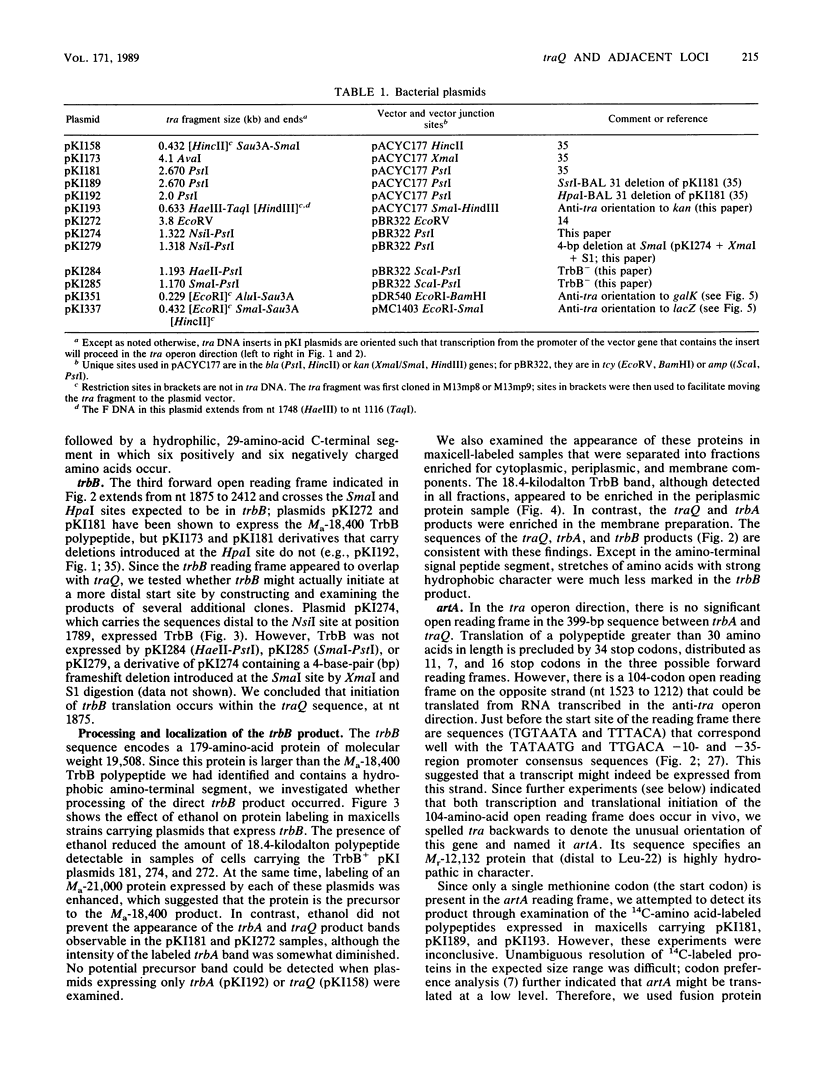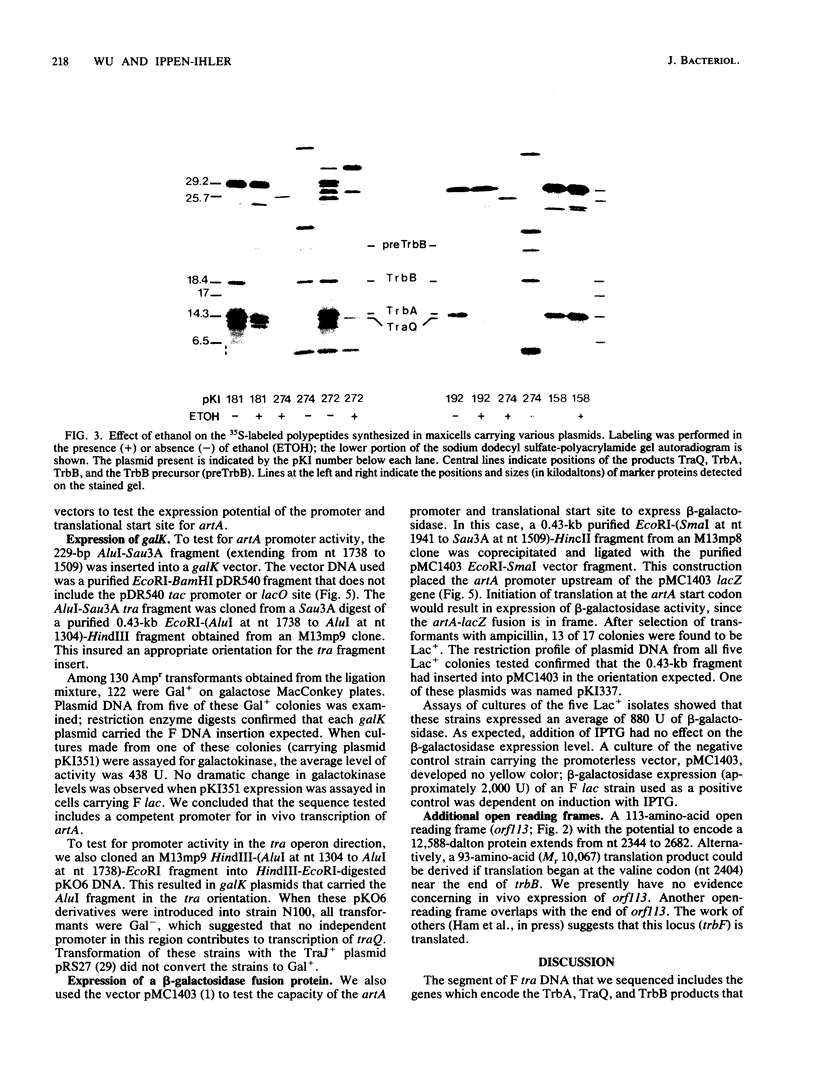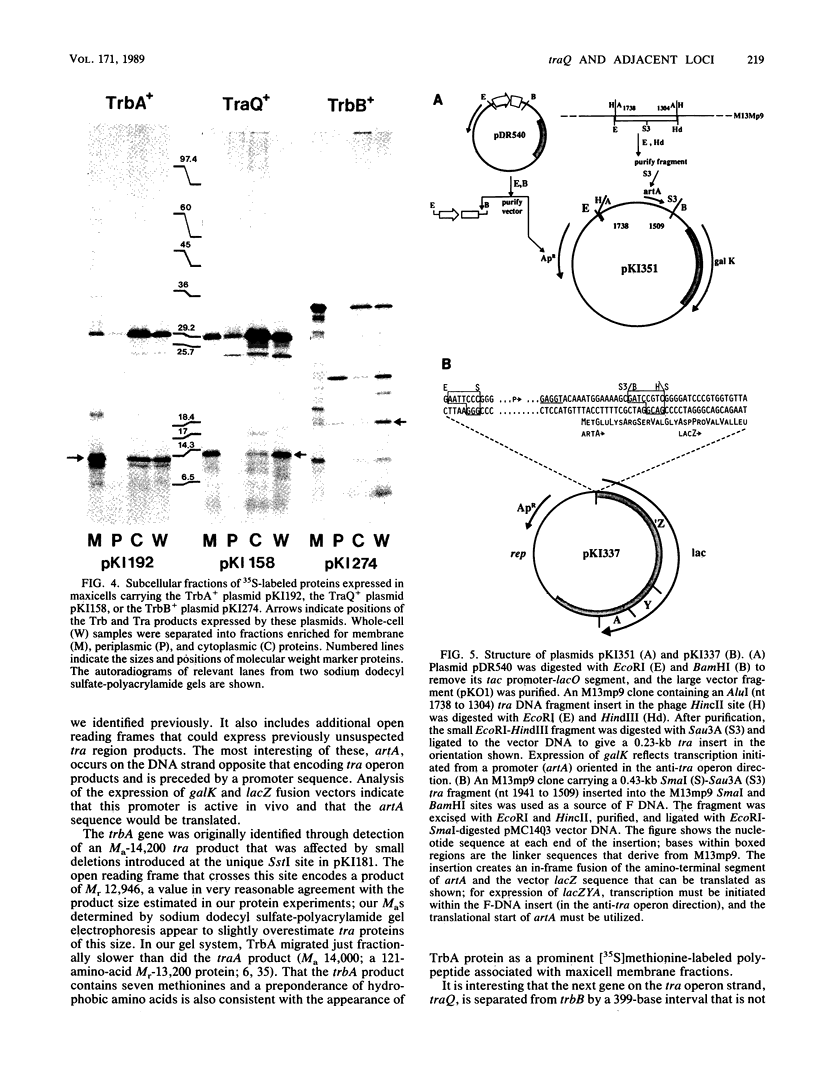Abstract
The F tra operon region that includes genes trbA, traQ, and trbB was analyzed. Determination of the DNA sequence showed that on the tra operon strand, the trbA gene begins 19 nucleotides (nt) distal to traF and encodes a 115-amino-acid, Mr-12,946 protein. The traQ gene begins 399 nt distal to trbA and encodes a 94-amino-acid, Mr-10,867 protein. The trbB gene, which encodes a 179-amino-acid, Mr-19,507 protein, was found to overlap slightly with traQ; its start codon begins 11 nt before the traQ stop codon. Protein analysis and subcellular fractionation of the products expressed by these genes indicated that the trbB product was processed and that the mature form of this protein accumulated in the periplasm. In contrast, the protein products of trbA and traQ appeared to be unprocessed, membrane-associated proteins. The DNA sequence also revealed the presence of a previously unsuspected locus, artA, in the region between trbA and traQ. The artA open reading frame was found to lie on the DNA strand complementary to that of the F tra operon and could encode a 104-amino-acid, 12,132-dalton polypeptide. Since this sequence would not be expressed as part of the tra operon, the activity of a potential artA promoter region was assessed in a galK fusion vector system. In vivo utilization of the artA promoter and translational start sites was also examined by testing expression of an artA-beta-galactosidase fusion protein. These results indicated that the artA gene is expressed from its own promoter.
Full text
PDF








Images in this article
Selected References
These references are in PubMed. This may not be the complete list of references from this article.
- Casadaban M. J., Chou J., Cohen S. N. In vitro gene fusions that join an enzymatically active beta-galactosidase segment to amino-terminal fragments of exogenous proteins: Escherichia coli plasmid vectors for the detection and cloning of translational initiation signals. J Bacteriol. 1980 Aug;143(2):971–980. doi: 10.1128/jb.143.2.971-980.1980. [DOI] [PMC free article] [PubMed] [Google Scholar]
- Dalbey R. E., Kuhn A., Wickner W. The internal signal sequence of Escherichia coli leader peptidase is necessary, but not sufficient, for its rapid membrane assembly. J Biol Chem. 1987 Sep 25;262(27):13241–13245. [PubMed] [Google Scholar]
- Dempsey W. B. Transcript analysis of the plasmid R100 traJ and finP genes. Mol Gen Genet. 1987 Oct;209(3):533–544. doi: 10.1007/BF00331160. [DOI] [PubMed] [Google Scholar]
- Finlay B. B., Frost L. S., Paranchych W., Willetts N. S. Nucleotide sequences of five IncF plasmid finP alleles. J Bacteriol. 1986 Aug;167(2):754–757. doi: 10.1128/jb.167.2.754-757.1986. [DOI] [PMC free article] [PubMed] [Google Scholar]
- Fowler T., Taylor L., Thompson R. The control region of the F plasmid transfer operon: DNA sequence of the traJ and traY genes and characterisation of the traY leads to Z promoter. Gene. 1983 Dec;26(1):79–89. doi: 10.1016/0378-1119(83)90038-0. [DOI] [PubMed] [Google Scholar]
- Frost L. S., Paranchych W., Willetts N. S. DNA sequence of the F traALE region that includes the gene for F pilin. J Bacteriol. 1984 Oct;160(1):395–401. doi: 10.1128/jb.160.1.395-401.1984. [DOI] [PMC free article] [PubMed] [Google Scholar]
- Gribskov M., Devereux J., Burgess R. R. The codon preference plot: graphic analysis of protein coding sequences and prediction of gene expression. Nucleic Acids Res. 1984 Jan 11;12(1 Pt 2):539–549. doi: 10.1093/nar/12.1part2.539. [DOI] [PMC free article] [PubMed] [Google Scholar]
- Hortsch M., Avossa D., Meyer D. I. A structural and functional analysis of the docking protein. Characterization of active domains by proteolysis and specific antibodies. J Biol Chem. 1985 Aug 5;260(16):9137–9145. [PubMed] [Google Scholar]
- Ippen-Ihler K. A., Minkley E. G., Jr The conjugation system of F, the fertility factor of Escherichia coli. Annu Rev Genet. 1986;20:593–624. doi: 10.1146/annurev.ge.20.120186.003113. [DOI] [PubMed] [Google Scholar]
- Ippen-Ihler K., Moore D., Laine S., Johnson D. A., Willetts N. S. Synthesis of F-pilin polypeptide in the absence of F traJ product. Plasmid. 1984 Mar;11(2):116–129. doi: 10.1016/0147-619x(84)90017-9. [DOI] [PubMed] [Google Scholar]
- Jalajakumari M. B., Guidolin A., Buhk H. J., Manning P. A., Ham L. M., Hodgson A. L., Cheah K. C., Skurray R. A. Surface exclusion genes traS and traT of the F sex factor of Escherichia coli K-12. Determination of the nucleotide sequence and promoter and terminator activities. J Mol Biol. 1987 Nov 5;198(1):1–11. doi: 10.1016/0022-2836(87)90452-9. [DOI] [PubMed] [Google Scholar]
- Laine S., Moore D., Kathir P., Ippen-Ihler K. Genes and gene products involved in the synthesis of F-pili. Basic Life Sci. 1985;30:535–553. doi: 10.1007/978-1-4613-2447-8_38. [DOI] [PubMed] [Google Scholar]
- Lauffer L., Garcia P. D., Harkins R. N., Coussens L., Ullrich A., Walter P. Topology of signal recognition particle receptor in endoplasmic reticulum membrane. 1985 Nov 28-Dec 4Nature. 318(6044):334–338. doi: 10.1038/318334a0. [DOI] [PubMed] [Google Scholar]
- Maneewannakul S., Kathir P., Moore D., Le L. A., Wu J. H., Ippen-Ihler K. Location of F plasmid transfer operon genes traC and traW and identification of the traW product. J Bacteriol. 1987 Nov;169(11):5119–5124. doi: 10.1128/jb.169.11.5119-5124.1987. [DOI] [PMC free article] [PubMed] [Google Scholar]
- Manning P. A., Morelli G., Fisseau C. RNA-polymerase binding sites within the tra region of the F factor of Escherichia coli K-12. Gene. 1984 Jan;27(1):121–123. doi: 10.1016/0378-1119(84)90245-2. [DOI] [PubMed] [Google Scholar]
- McKenney K., Shimatake H., Court D., Schmeissner U., Brady C., Rosenberg M. A system to study promoter and terminator signals recognized by Escherichia coli RNA polymerase. Gene Amplif Anal. 1981;2:383–415. [PubMed] [Google Scholar]
- Messing J., Crea R., Seeburg P. H. A system for shotgun DNA sequencing. Nucleic Acids Res. 1981 Jan 24;9(2):309–321. doi: 10.1093/nar/9.2.309. [DOI] [PMC free article] [PubMed] [Google Scholar]
- Messing J., Vieira J. A new pair of M13 vectors for selecting either DNA strand of double-digest restriction fragments. Gene. 1982 Oct;19(3):269–276. doi: 10.1016/0378-1119(82)90016-6. [DOI] [PubMed] [Google Scholar]
- Minkley E. G., Jr, Polen S., Brinton C. C., Jr, Ippen-Ihler K. Identification of the structural gene for F-pilin. J Mol Biol. 1976 Nov;108(1):111–121. doi: 10.1016/s0022-2836(76)80098-8. [DOI] [PubMed] [Google Scholar]
- Moore D., Sowa B. A., Ippen-Ihler K. A new activity in the Ftra operon which is required for F-pilin synthesis. Mol Gen Genet. 1982;188(3):459–464. doi: 10.1007/BF00330049. [DOI] [PubMed] [Google Scholar]
- Moore D., Sowa B. A., Ippen-Ihler K. Location of an F-pilin pool in the inner membrane. J Bacteriol. 1981 Apr;146(1):251–259. doi: 10.1128/jb.146.1.251-259.1981. [DOI] [PMC free article] [PubMed] [Google Scholar]
- Moore D., Wu J. H., Kathir P., Hamilton C. M., Ippen-Ihler K. Analysis of transfer genes and gene products within the traB-traC region of the Escherichia coli fertility factor, F. J Bacteriol. 1987 Sep;169(9):3994–4002. doi: 10.1128/jb.169.9.3994-4002.1987. [DOI] [PMC free article] [PubMed] [Google Scholar]
- Mullineaux P., Willetts N. Promoters in the transfer region of plasmid F. Basic Life Sci. 1985;30:605–614. doi: 10.1007/978-1-4613-2447-8_42. [DOI] [PubMed] [Google Scholar]
- Newman A. J., Ma J. C., Howe K. M., Garner I., Hayward R. S. Evidence that rifampicin can stimulate readthrough of transcriptional terminators in Escherichia coli, including the attenuator of the rpoBC operon. Nucleic Acids Res. 1982 Nov 25;10(22):7409–7424. doi: 10.1093/nar/10.22.7409. [DOI] [PMC free article] [PubMed] [Google Scholar]
- Rosenberg M., Court D. Regulatory sequences involved in the promotion and termination of RNA transcription. Annu Rev Genet. 1979;13:319–353. doi: 10.1146/annurev.ge.13.120179.001535. [DOI] [PubMed] [Google Scholar]
- Russell D. R., Bennett G. N. Construction and analysis of in vivo activity of E. coli promoter hybrids and promoter mutants that alter the -35 to -10 spacing. Gene. 1982 Dec;20(2):231–243. doi: 10.1016/0378-1119(82)90042-7. [DOI] [PubMed] [Google Scholar]
- Skurray R. A., Nagaishi H., Clark A. J. Molecular cloning of DNA from F sex factor of Escherichia coli K-12. Proc Natl Acad Sci U S A. 1976 Jan;73(1):64–68. doi: 10.1073/pnas.73.1.64. [DOI] [PMC free article] [PubMed] [Google Scholar]
- Thompson R., Taylor L. Promoter mapping and DNA sequencing of the F plasmid transfer genes traM and traJ. Mol Gen Genet. 1982;188(3):513–518. doi: 10.1007/BF00330058. [DOI] [PubMed] [Google Scholar]
- Willetts N., Skurray R. The conjugation system of F-like plasmids. Annu Rev Genet. 1980;14:41–76. doi: 10.1146/annurev.ge.14.120180.000353. [DOI] [PubMed] [Google Scholar]
- Wolfe P. B., Wickner W., Goodman J. M. Sequence of the leader peptidase gene of Escherichia coli and the orientation of leader peptidase in the bacterial envelope. J Biol Chem. 1983 Oct 10;258(19):12073–12080. [PubMed] [Google Scholar]
- Wu J. H., Kathir P., Ippen-Ihler K. The product of the F plasmid transfer operon gene, traF, is a periplasmic protein. J Bacteriol. 1988 Aug;170(8):3633–3639. doi: 10.1128/jb.170.8.3633-3639.1988. [DOI] [PMC free article] [PubMed] [Google Scholar]
- Wu J. H., Moore D., Lee T., Ippen-Ihler K. Analysis of Escherichia coli K12 F factor transfer genes: traQ, trbA, and trbB. Plasmid. 1987 Jul;18(1):54–69. doi: 10.1016/0147-619x(87)90078-3. [DOI] [PubMed] [Google Scholar]
- Zwizinski C., Date T., Wickner W. Leader peptidase is found in both the inner and outer membranes of Escherichia coli. J Biol Chem. 1981 Apr 10;256(7):3593–3597. [PubMed] [Google Scholar]




